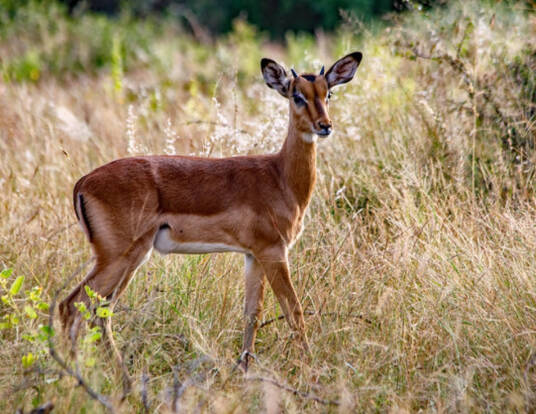Cephalophus dorsalis
IUCN
LCBasic Information
Scientific classification
- name:Cephalophus dorsalis
- Scientific Name:Cephalophus dorsalis,Bay Duiker, Céphalophe bai、Céphalophe à bande dorsale noire, Duiquero Bayo,Schwarzrückenducker,Black-backed antelope, Gulf antelope
- Outline:Ungulata
- Family:Artiodactylus Bovidae Gazella
Vital signs
- length:76-103cm
- Weight:18-24kg
- lifetime:About 15 years
Feature
Bright white spot above each eye
Distribution and Habitat
Distributed in Angola, Cameroon, Central African Republic, Congo (Brazzaville), Congo (Kinshasa), Côte d'Ivoire, Equatorial Guinea, Gabon, Ghana, Guinea, Guinea-Bissau, Liberia, Nigeria, Sierra Leone and Togo.
The distribution is discontinuous, distributed in forests from Guinea-Bissau to Togo in West Africa; in central Africa, in mountain forests east of the Niger River to eastern Congo (Brazzaville), and south to northeast of Angola at about 11°S. There are no confirmed records from Gambia or Benin. It was once distributed in Uganda, but it is extinct.
Inhabits original and relatively unmodified equatorial forests from lowlands to mid-elevation altitudes. Although the species shows a preference for high primary rainforests, they may occupy patches of savanna and forest, and also occur in old farm shrubs and old secondary forests.
Appearance
The bay duiker is 76-103 cm long, 45-52 cm tall at the shoulder, 8-12 cm long tail, and weighs 18-24 kg. Females are generally larger than males, and there are two subspecies, with the bay duiker in central Africa being larger than the west African subspecies in western Africa. Both sexes are reddish brown with a very striking black stripe running from the back of the head to the tail. The legs are dark brown, and the tail is black above and white below. The belly is the same color as the sides, but there is a dark stripe down the center line of the belly. The red cheeks have a black flame pattern that runs from the nose to the top of the forehead. There are white spots above the eyes, on the lips and chin. The cheek muscles of this species are very strong and powerful. Both sexes have a pair of short, pointed horns that extend back from the forehead; males are usually 5-8 cm long, while females have shorter horns.
Details
Bay Duiker (scientific name: Cephalophus dorsalis) English: Bay Duiker, French: Céphalophe bai, Céphalophe à bande dorsale noire, Spanish: Duiquero Bayo, German: Schwarzrückenducker, has 2 subspecies.

In the wild, the similar “red duiker” species are often difficult to tell apart based on a brief glance. The bay duiker is distinctive for its nocturnal habits and the bright white spot above each eye. The Austrian duiker can be identified by its pale underparts and dorsal stripes that end at the shoulders with no clear distinction at the neck. The dorsal stripes of the white-bellied duiker are less distinct, widening in the middle of the back and pale on the belly. The dorsal stripes of the blue-rumped duiker widen from the shoulders and cover the entire rump. The dorsal stripes of the bay duiker easily distinguish it from the unstriped black-fronted duiker and the Wessler duiker.
The bay duiker lives alone and is a nocturnal species, which is ecologically isolated from duikers of the same size living in the same habitat. During the day, individuals rest in dense bushes or woods. The home territory of females is 0.2-0.4 square kilometers; the territory of males may be more than twice that area. Bay duikers are sensitive to smell and use their noses to find food, detect danger, and communicate with other animals of the same species through the use of preorbital gland secretions, urine, and feces. If a threat is detected, the bay duiker will usually stop and watch; if startled, they will hop and flee into dense bushes and grass.
The bay duiker feeds primarily on fruits and seeds, but also eats plant leaves, fungi, flowers, and even animal matter, including invertebrates, eggs, and birds.
The bay duiker has no specific breeding season, but the peak birth season in Central Africa is January-February. The gestation period for females is about 240 days, and each litter has one calf. The calves are born with a uniform dark brown coat, which begins to develop a bright chestnut color at 5-6 months. In the first few weeks of life, the calves will hide in dense vegetation while the mother goes out to forage for food. The weaning period averages 3.5 months, and female calves become sexually mature at 18 months. Captive species can live up to 17 years.
The estimated total density of the bay duiker in 1999 was 725,000 individuals. Densities are typically 1.5-8.7 individuals per square kilometer. Although its population is generally stable in less disturbed forests where hunting pressure is relatively low, its overall population is declining due to habitat loss and overhunting for meat in other parts of its range.
Listed in the IUCN Red List of Threatened Species in 2016 ver3.1 - Least Concern (LC).
Listed in Appendix I, Appendix II and Appendix III of the Convention on International Trade in Endangered Species of Wild Fauna and Flora (CITES) 2019 Edition.
Protect wild animals and eliminate game.
Maintaining ecological balance is everyone's responsibility!








